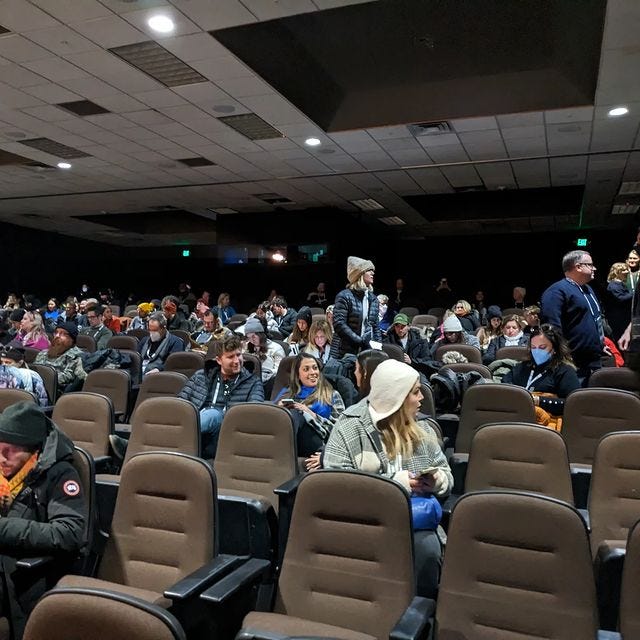Links & Looks. January 23, 2023
Sundance Empty Seats; Hard Road For Docs; Mike Hodges Correspondence; Ted Hope On Streaming's Inevitable Fiscal Catastrophe; Anime "Everywhere"?; Babylon!
Sundance 2013. Photo: Ray Pride.
Film festivals, like distributors, keep distance from “controversial movies,” reports Variety.
Everything is being placed under a “microscope of scrutiny,” says veteran film finance attorney Marc Simon, who observes: “These are complicated times.”
In fact, that quick-to-capitulate reflex underscores a new, unspoken modus operandi in which festivals—once the bastion of provocative, button-pushing fare—are desperate to avoid controversy and the wrath of any identity-focused Twitter mob [sic]…
“If we see something that we think is going to be problematic, we might shy away from it, even if we think it’s a good film,” says Submarine’s Josh Braun. “Everyone is probably a little more attuned to what could end up being problematic. There’s ‘controversial,’ and then there’s ‘problematic.’ I think that’s a fine line.”…
The Sundance application now asks filmmakers about the backstory of docs being submitted and for additional information on the subjects.
Anecdotal evidence online suggests that Sundance screenings in Park City are not packed, as would have been the case before pandemic.
Writes Kaufman: “A weekend screening. At the Sundance 2023 Film Festival. For a crowd pleasing comedy that has gotten good reviews. Empty seats everywhere.” He later adds that it was a P&I screening, “not public, so just not a lot of press & industry in person here.” Or has it something to do with passholders?




Sundance 2014. Photo: Ray Pride.
Fewer than twenty-percent of all documentaries sell at top-tier American film festivals, writes Anthony Kaufman at Distribution Advocates.
The barriers to entry are many, the first of which is simply getting admitted into an A-list festival. Acceptance rates last year, for example, ranged from approximately only 2% (for Sundance) to 4.2% (for SXSW)... Most accepted films (57%) had a producer or director that previously showed a film at the same festival, suggesting that newbies are in the minority. Demographic data also indicates that female film teams have made gains in recent years (nearly 56% of documentary makers participating at the festivals were female), but diversity remains painfully lacking, with 8.7% of those polled identifying as Hispanic, 5.8% as Black or African Americans, and nearly 70% as white or European. “I find that troublesome, especially with Sundance,” said Su Kim, the Emmy-winning producer of 2022 Sundance entry Free Chol Soo Lee and Oscar shortlisted doc Hidden Letters, “because that was the festival for the outsiders, and it started for a place of highlighting voices, and I think that is changing now.”
Mike Hodges was collaborating until his last days, writes filmmaker Graham Bendel, proferring a packet of his correspondence with the late filmmaking great.
It’s so strange living in a world where only the “now” matters.
Maybe it was always thus?
As an old man I see the same problems being recycled time and time again.
In the 60s we thought we’d severed so many Gordian knots – how naive !
Thatcher retied them and so we go on and on in a never-ending charade.
Streaming. Photo: Ray Pride.
Producer Ted Hope on the predictable economic catastrophe of the megacorporate race to streaming and saunters through the rubble:
One of the great comforts in this world is that the best and the brightest, the most powerful and best capitalized, make dumb ass decisions time and time again…
If there has been a consistent end-of-year cheer, it’s that it was generally stupid to pivot to a streaming-first strategy. And frankly they started that cheer early in 2022. Yay! Time to flip-flop again! Not only was money left on the table, but it ate up more than it could spit out. Forget that DirectToStreaming (D2S) wasn’t a way to build long term value or give a title any distinction. It was a costly lesson and everyone is paying the price…
I was surprised that the major streamers never moved into curation in any significant way. It is said that curation is an audience retention tactic and not one of the prime streaming goal: audience acquisition. Do you remember the formulas? I thought someone was going to better algebratize them for me!
And from an earlier dispatch of Hope:
Our entire film ecosystem was structured around content scarcity until the Global Streamers pushed everything towards “Peak Content.” The scarcity model required us to maximize individual title revenue’s by creating specific hierarchies and cadences for releasing a title across different media platforms and territories. Success was generally evaluated by the profit or loss a film generated.
We are no longer a culture or industry of scarcity. We are now a culture and industry of abundance. We changed because the dominant powers had different business goals and their tactics for trying to reach those goals changed everything. The business goal of Global Streaming is not the profit a single title generates. The business goal of Global Streaming is audience acquisition.
At teh Grauniad, Phil Hebblethwaite on musical choices in Tár.
Babylon and on:




NPR sees anime “everywhere.” “Anime's fans are largely online, and the pandemic—when people were suddenly able to focus on at-home or online interests—[fueled] growth.”
It's a young demographic consuming the majority of popular anime, and that's a good thing, said Anime NYC director Peter Tatara, since those early impressions are formative. Teens "see themselves reflected through these heroes in a way they might not see themselves reflected in a billionaire who builds a suit of armor," Tatara told the network.








